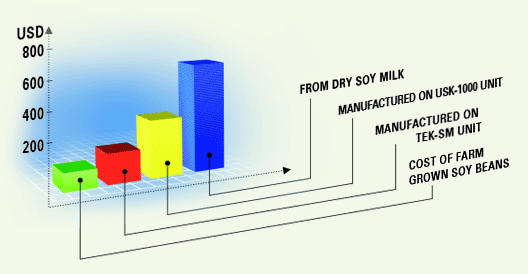ANIMAL FEEDING » TOPIC IMPORTANCE
TOPIC IMPORTANCE
The dry" method of animal feeding with
the utilization of mixed balanced fodders, alongside with
its indisputable advantages of long shelf life and minimization
of manual labor, also led to mass cattle epidemics of lungs
silicosis, stomach disorders, etc.
After heavy thermal treatment, dry fodder mixes
keep only a splinter of natural nutritive ingredients originally
contained in raw products. Besides, balanced fodder mix prices
are significantly higher than the price of raw materials used
for its production.
Moreover, if we take into consideration the fact that the majority
of cattle-breeding farms grow their own soy, peas, wheat, etc.,
and if we also recall the old fodder production technology,
which included raw materials scalding, mixing and crushing for
better assimilation, a creation of a technology for local wet
fodder production becomes evident. It should be mentioned that
the new technology should be less labor-extensive and more energy-saving
compared to the old techniques applied by our forefathers.
As an example of "wet fodder production technology,
we can mention a soy beans processing technology, keeping
in mind that soy beans are the primary source of protein content
of any balanced fodder mix.
It is well known that soy is a treasure chest of essential
amino acids, polyunsaturated fatty acids, poly- and monosaccharides,
vitamins of groups B and C, a number of microelements. Presence
of several harmful ingredients (trypsin inhibitor, urease
and other ferments) requires mandatory thermal treatment of
soy beans, which in combination with the soaking process usually
rockets the processing cost comparing to the processing cost
of wheat.
Relative cheapness and long shelf life of the soy product
made in extruder (equipment creating high pressure and, consequently,
high temperature) does not make up for a poor quality of the
end product (soy cake), because the latter loses a greater
part of its vitamins, unique linoleic and linolenic fatty
acids, etc. Besides, as researches show, trypsin inhibitor
is not neutralized to a safe level for living organisms.
The so called "soy cows" have recently become
widely spread in Ukraine. These are the machines where finely
ground soy beans undergo thermal treatment with steam
COST OF 1 METRIC TON OF SOY MILK MANUFACTURED
UTILIZING VARIOUS TECHNOLOGIES
(calculation is based on Ukrainian conditions)

Notorious energy extravagance of a steam generator is well
known, and this drawback cannot be compensated by a relatively
high quality of soy milk, the end product of this technology.
Besides, soy cows produce about 30% of insoluble sediment
(fiber, cellulose, etc.), which in real-life farming conditions
creates significant problems for even fodder distribution.
Multiple soy beans soaking and rinsing is yet another factor
downgrading the nutritive value of soy milk produced by "soy
cows, since it washes out soluble proteins, starch and sugars.
Most of these technologies also include soy beans shelling
and hulling cycles, which also leads to further losses of
nutrients. In order to avoid environment pollution with production
waste, the waste water generated during soy cows operation
must undergo expensive water treatment.
Thus, application of soy milk produced by conventional technologies
does not allow to cut the net cost of raising young cattle
and pigs.
Innovative processing technology by TEKMASH®
is not burdened by these disadvantages. It implies the production
of soy paste with dry matter content of 15...35% with further
thinning it to soy milk consistency. The technology does not
require preliminary grinding: mixing, thermal treatment and
mixture homogenization are combined in one cycle in TEK-SM
unit, due to the application of a number of hydrodynamic effects.
No steam or heat exchange equipment is used, that is why
this machine can be referred to as energy-saving equipment
(the amount of electricity required for the processing of
1lb of soy beans is only 0.23-0.27 kWhour).
Soy beans soaking under TEKMASH® technology
happens only once, and all water remaining in a tub after
soy saturation goes in the machine reservoir. This means that
all soluble nutrients solved in this water will get to the
end product. Soy beans shelling or hulling are not required
either. In other words, all of this confirms that TEKMASH®
technology is wasteless and environment friendly.
Application of an anaerobic soy processing technology in
a hydromodule allows to keep the entire complex of vitamins,
minerals, amino acids, polyunsaturated fatty acids, fiber
and sugars in the end product, unlike in soy cake and soy
flour, where the content of nutrients is significantly lower.
The net cost of soy milk
production under TEKMASH® technology is 1.7
to 2.2 times lower than the soy milk cost under the soy cows
technology. Owing to this, a cattle breeding farm can save
18...22% on the fattening of just one calf.
TEKMASH® soy beans processing technology
with TEK-SM equipment allows:
- to raise the farms profit margins by 18...22% by cutting
the fodders cost;
- to keep all nutritive ingredients contained in soy beans;
- to reduce the net cost of soy milk:
- by almost 4 times comparing to the cost of milk produced
from soy flour;
- by 1.7-2.2 times comparing to the cost of milk produced
under the conventional technology using steam;
- to cut energy consumption by 3 to 5 times comparing to
the conventional processing methods;
- to add necessary mineral components in the fodder mix
in the process of production;
- to eliminate the necessity to use expensive waste treatment
facilities.
Printer
Version |